
It’s a strange time for me to sit down and attempt to don the gadget reviewer hat. I was solo parenting a sick kid for the week, and then the rest of my family contracted the stupid virus, which meant this review had to take a backseat. There was much crying, mucus, missed deadlines, and a copious amount of video chat—more than I had anticipated.
I bring up my chaotic life because the Samsung Galaxy Z Fold 4, a smartphone that folds open like a book and has the thickness of a Moleskine notebook, isn’t immediately marketed to someone like me. If you go to the main Samsung website for the Z Fold 4, you see some very chic folks with tailored clothing, brushed-out coifs, and no screaming children surrounding them. I looked nothing like this while reviewing this phone. I was stressed, with bags under my eyes and frizzy hair I didn’t have time to comb out. I was lucky to wear a pair of leggings that didn’t have a hole.
And yet, the Galaxy Z Fold 4 saved my ass during a week when everything in my life that could go wrong did. It came in handy when I didn’t have time to sit at my desk to take care of work, and it kept my toddler entertained enough that I could pick up around the house. It also became my bedtime companion, allowing me to easily watch TV on one side and catch up on the headlines on the other before dosing off for the night. My regular-sized smartphone could have done the same, but the Fold saved me the hassle of switching between tasks when I needed to multitask without something else getting in my way and causing me to burst into tears.
I imagine the main reason Samsung isn’t marketing the Galaxy Z Fold 4 to folks like me is that this foldable starts at $1800. That’s a ton of money for a middle-class household that might otherwise have that kind of money budgeted for a host of other things. But wouldn’t it be nice for Samsung to figure out a way to dial down the price of the Z Fold 4 so that more people can afford this fun and functional form factor?
From phone to tablet and back again
It’s my first time with a Galaxy Z Fold device. Since Samsung started producing folding smartphones, I’ve only handled the Galaxy Z Flip. I was worried that the Fold 4 wouldn’t resonate with me because of how thick it is on the outside and how big it is when you open it up. I thought, “who’d want to wield a tablet all day?” It turns out I do.
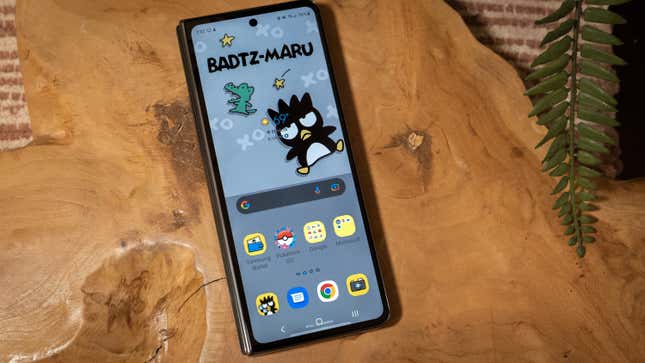
From the front, the Galaxy Z Fold 4 is a 6.2-inch smartphone. It’s much narrower than many Android phones available now, so it took me a while to adjust to handling it. The phone’s thickness also throws off the balance as you’re wielding it one-handed, which is especially hard for me, since I usually rely on a pop socket to help me wrangle smartphones with just one hand.
The tablet mode comes with an advantage that helps offset these issues, though. I usually struggle tapping buttons and typing without typos since I’m a girl with claws and need more touchscreen space to get my finger on the screen. But in most cases, if I needed to get serious typing done on the Fold, I could open the screen into two-handed typing mode and get the sentence out fast, whether it was a text message or email.
Closed up, the Galaxy Z Fold 4 is about 0.62-inches thick. It doesn’t feel thicker than the Pixel 6 Pro with a case on it, and I had no problem fitting this device into my smaller bags. Its narrow form also requires less room than another wider Samsung hit, the Galaxy S22+, so it fits into more clutches.
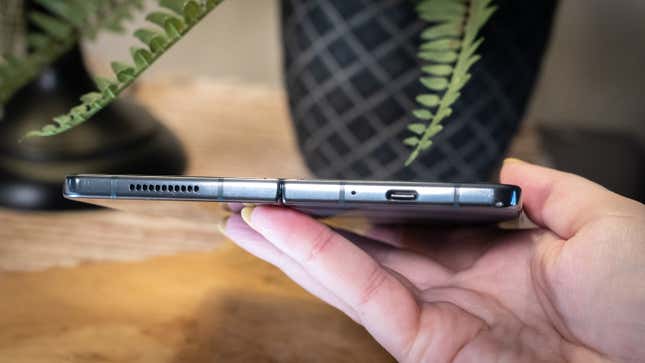
When it’s opened up, the Galaxy Z Fold 4's side hinge disappears into the phone’s chassis to reveal a 7.6-inch QXGA+ Dynamic AMOLED display with a 120Hz refresh rate. Since this is a patented Samsung display, everything pops with a tinge of saturation, whether it’s a Google Doc or your seventh hour of TikTok. Samsung’s AMOLED screens also have the upside of being able to get really dim, so this is a smartphone you can comfortably read in the dark after a few settings changes.
The Galaxy Z Fold 4 has profound Nexus 7 vibes when in tablet mode—and that was arguably the last great Android tablet. I liked that tablet because it was something I could hold one-handed, which you can also do with the Fold 4 while it’s splayed out. But the real upside to the Fold is that it has a built-in kickstand: you can prop up the phone like a book to watch video and scroll through your feeds or turn it around to use the cover Screen as a preview window for filming videos with the rear cameras.
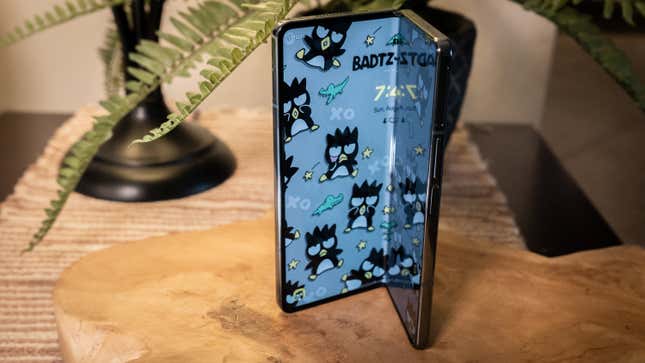
There are a few caveats to this form factor. For one, the seam in the middle of the device is quite noticeable, and while it didn’t bother me, I can see it being a deal breaker for some. Second, it’s clear that this is a smartphone moonlighting as a tablet when laid flat on a table because of its protruding camera system—the bottom right corner rocks back and forth like a restaurant chair with an uneven leg. You’ll also want to consider a case for the device, because the Fold 4 is too slippery to go naked. I often had to move fast to catch the Fold 4 from falling.
Durability is dubious
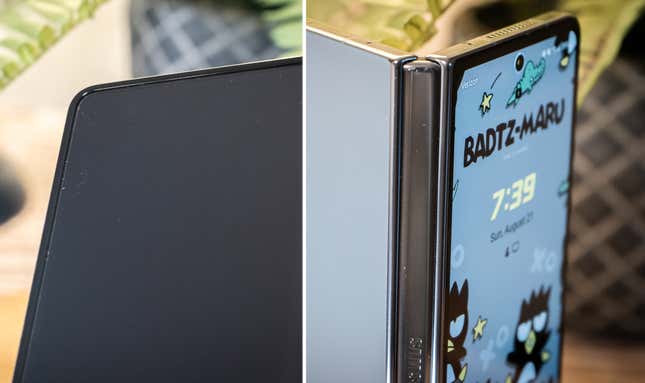
If there’s an issue I have with the Fold’s design, its durability. Samsung said its newest devices are its “toughest foldables ever,” but I can already see some fraying around the hinges from when my kid pushed down the device while she was video chatting with her other parent.
Let’s start with the good. The Galaxy Z Fold 4 has a water resistance rating of IPX8, the same as its predecessor, the Z Fold 3. This means it’s resistant in up to 3.2 feet of fresh water for up to half an hour. That does not mean you can take the device into the sea to film your next underwater adventure. But it means you can use the device while your kid splashes next to you in the bath without much worry.
The Z Fold 4’s screens are protected by Gorilla Glass Victus+, which supposedly reinforces their longevity for daily use. I was impressed at the glass’s resistance to fingerprints, especially since I’m a greasy mess who eats around her devices. It still gets nasty, but it’s not as bad as I imagined. The rest of the device chassis is made of Samsung’s Armor Aluminum alloy.
The Z Fold 4 still has a built-in screen protector to help keep everything in place—think of it like Spanx for the foldable smartphone, except rather than squeezing out of it at the end of the night, it’s not to be removed by anyone besides a qualified professional.
That screen protector is where things get rough. While the outside screen survived the keys-in-my-purse test, the inside screen did not. Already, there’s a bit of a squiggly scratch in the top left corner of my review device.
This particular screen overlay is also notorious for bubbling up after some use. It’s not something I would encounter during the review period, but it’s something we experienced with the Galaxy Z Fold 2, and others have complained about it with the Galaxy Z Fold 3.
How I learned to love split-screen mode
The best part of using the Z Fold 4 is its inside screen, though it wouldn’t be as intuitive to use without the help of Android 12L. That provides the folding device framework for Samsung’s One UI 4.1.1. It also enables the fantastic taskbar, though it only pops up when you’re in an app outside the Home screen. The taskbar is reminiscent of the one that’s on Chrome OS; you can switch between docked apps from it as well as your two last-used apps.
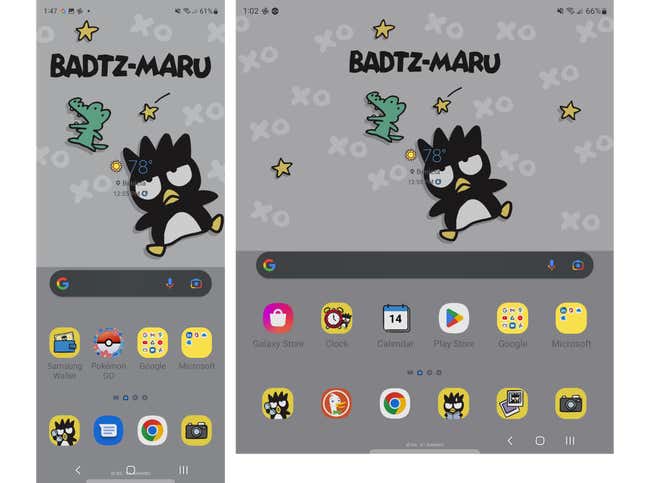
The Z Fold 4’s most helpful interface mechanism is the split-screen mode. I spent most of my time with this smartphone open with an app pinned on each side. The ability works like on Windows 11; tap and drag the app you want to pin from the app drawer, dock, or multitasking screen to one side of the phone, and then do the same for the other side. It’s intuitive if you’ve used split-screen mode in Android before, and you can adjust each side of the app as needed. The Fold 4 can run a maximum of three apps at a time.
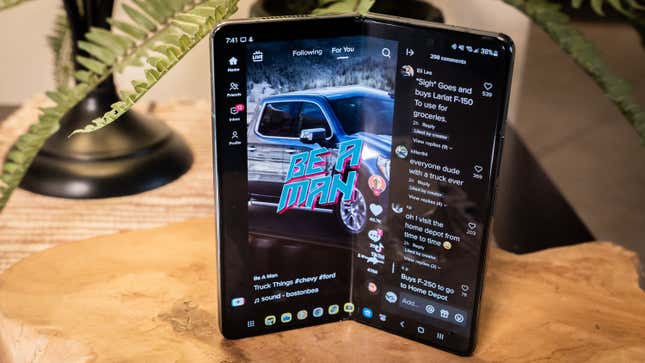
Unfortunately, not every app is suited to work on this phone/tablet-style device. TikTok, for instance, works fine in the tablet mode, since it was optimized a while back, but elements like the captions don’t always scale properly and often appear cut off. Apps without a tablet mode, like Instagram, remain within a phone-sized resolution, and you can switch whether you want the app on the left or right side of the device. You could also have it smack dab in the middle of the screen, but it can be confusing to use the app that way; I forget that it only works within that part of the screen and then get tripped up as to why my tapping outside that area isn’t doing anything.
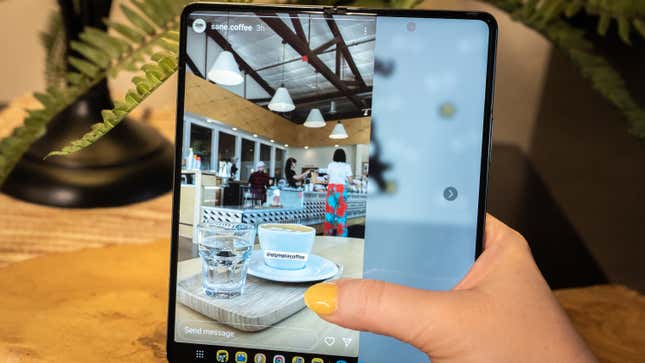
My favorite way to use the Z Fold 4’s built-in tablet mode is for reading. My newspaper app navigates nicely, and I can peruse the “e-edition” of the paper more easily than I would in landscape mode on a regular smartphone. I even built a ritual at the end of each day around reading my kid’s school newsletter, which comes in daily as a PDF. I’d have my inbox open to one side to see what’s come in while I’ve been on the clock and the school newsletter on the other. Occasionally, I’d shove in the afternoon’s Beverly Hills, 90210 stream via Pluto TV, which would take up one half of the screen, with the two others taking up a quarter of the remaining half.

Samsung did bundle in a feature called Flex Mode, but I only used it to try it once. It turns the bottom screen (when using the device in landscape mode) into a trackpad of sorts to help you get more precise with your swipes. You can also use the inside of the Z Fold 4 with a (sold separately) S Pen. I’m still bummed that we didn’t get a full-on slot for an S22 Ultra-sized S Pen, although a case can help with that.
Gaming on the fold is... a little different
The Galaxy Z Fold 4 is equipped with one of the latest processors from Qualcomm, and it’s nice to see this particular device as a “bump up” in specs from the year’s marquee flagship, the Galaxy S22 series. The Fold 4 runs on the upgraded Snapdragon 8+ Gen 1 silicon with 12GB of RAM and up to 1TB of onboard storage. This configuration is plenty for doing what you want with the Fold 4, including playing locally-stored games and cloud-launched exclusives.
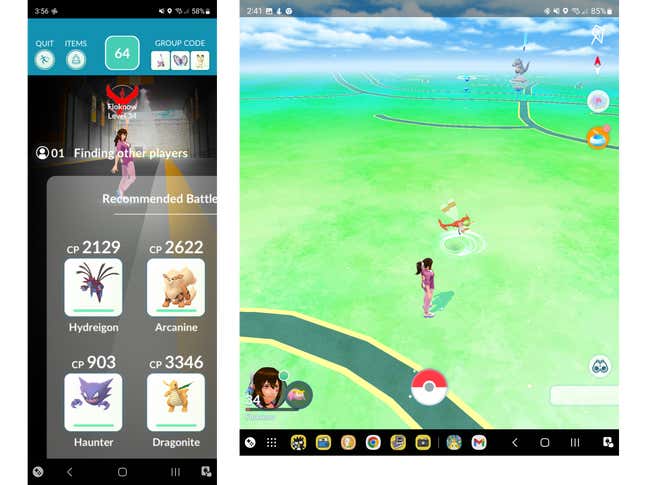
There are some caveats to gaming on this transforming device, however. The inside screen may not work with every title out there, nor will the layout revert to “smartphone mode” when you close the screen on some games, even if you go into the Samsung Labs settings and select the option to force it. Mobile games like Pokémon Go and Animal Crossing: Pocket Camp appeared stretched out on tablet mode, and Pokémon Go always required a restart when I closed up the Fold.
My biggest annoyance with gaming on the Z Fold 4 is that it doesn’t fit inside my first-generation Razer Kishi for handheld play. Instead, I have to use a separate Bluetooth gaming controller and prop up the phone on its own or use a smartphone stand to play a game seriously. Touch gaming can also be difficult if it relies on virtual controls and your hands don’t quite fit the device when it’s in tablet mode.
According to our internal benchmarks, the Z Fold 4 is just a tad more punchy than the last Snapdragon 8+ Gen 1 smartphone I tested, the OnePlus 10T. The Geekbench 5 numbers were only about 300 points more for both single-core and multi-core benchmarks.
I also ran the Galaxy Z Fold 4 through our internal battery benchmarks. I focused squarely on the inside screen, because the big screen is the whole point. At about 200 nits, the Z Fold 4’s internal screen lasted nearly 15 hours in our video playback test on its 4400 mAh battery. That is more than three hours less than last year’s device. Regardless, I found battery life to be pretty good for daily use between the front screen and internal display, enough that I wasn’t apprehensive about leaving the house with less than 60% on the meter. And there are ways to help save on battery life, like dialing down the refresh rate, so it’s not constantly pulsing at 120Hz.
The Z Fold 4 charges wirelessly, which is super handy for the end of the night, when I barely have the energy to plug it in. It’s also capable of super-fast charging, up to 50% in half an hour with a 25-watt charger or higher. Indeed, I managed to get the device fully charged up in an hour and 20 minutes with a 20-watt charger. The Fold 4 can also wirelessly power share if you have a compatible set of earbuds or another mobile device that needs some juice.
Better cameras, but not the best
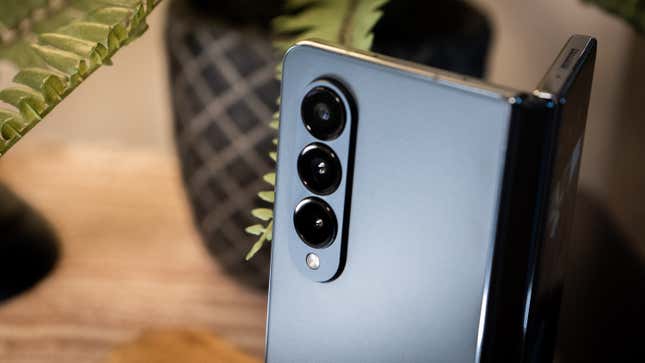
Finally, buying a Samsung foldable doesn’t mean getting camera specifications that are a year behind the company’s latest flagships. The Z Fold 4 may not have the intense Space Zoom capabilities of the Galaxy S22 Ultra, but there is a 10-MP telephoto camera with 3x optical zoom, which can capture enough grass on the other side of a hill to get you an idea of what’s going on. I also liked the zoom while filming videos, which appeared incredibly smooth as it transitioned from 1x to 3x.

The primary camera is a 50-MP wide-angle camera with optical image stabilization (OIS), an f/1.8 aperture for capable nighttime shots, and an 85-degree field-of-view (FoV). There’s also a 12-MP ultra-wide camera with a 123-degree FoV, which is great for landscape shots and videos of my kid running around the playground.
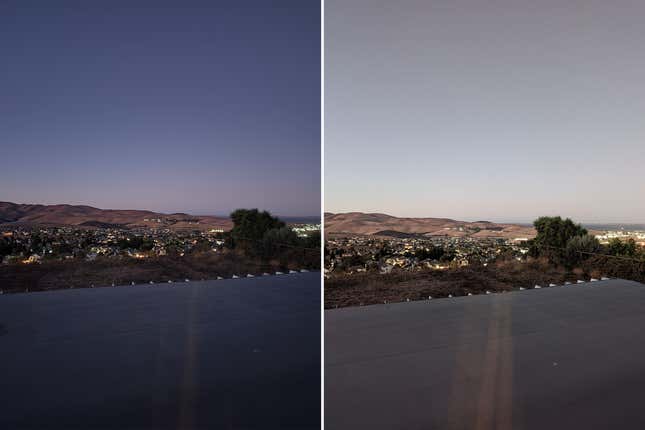
The night mode on the Fold 4 is still nothing akin to the Pixel 6 Pro, though it’s the best it’s ever been. You can take a long exposure shot, but if you want to keep the shutter open for longer than 30-seconds, you’ll need to dig into Samsung’s Pro camera mode to make that happen.
The front-facing camera on the Galaxy Z Fold 4 is a 10-MP camera with an 85-degree FoV. I preferred it over the inside under-display camera, which is a measly 4-MP camera with an 80-degree FoV. Whether you’re filming TikToks or chatting on a Microsoft Teams conference or whatever it is you do all day if you’re in meetings, you can tell the difference in resolution between the inside and outside selfie cameras. In terms of filming videos, it’s so much easier to do with the Galaxy Z Flip’s form factor.
How will you pay for this phone?
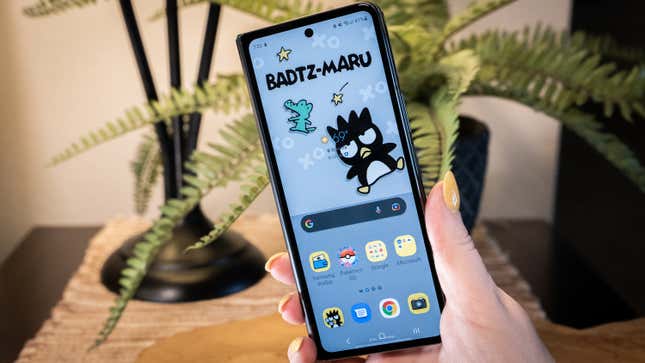
It took me longer than anticipated to put together this review of the Galaxy Z Fold 4 because of life’s unexpected happenings. But in between bouts of writing about this foldable, I kept making excuses to spend time with it since it was such a welcome escape from the hell that was caretaking for my plague-ridden family. I understand more why a person would flock to this particular form factor, despite the exorbitant price tag that is essentially a month of childcare in some households.
The Z Fold 4 is the all-you-can-eat buffet of smartphones. Even if you’re not the type of person taking Serious Calls™ with it all the time, the sheer nature of being able to flip it open into a bigger screen adds just a bit of levity to the heaviness of the daily agenda. I look forward to evenings when I can come down from the day with the device in tow.
If you think it’s time to bring this kind of device into your life and you’re scratching your head about how to pay for it, I hope you can feel comforted knowing that I am, too, despite my ability to go hands-on with these things for work. You could trade in a few of your smartphones to try and bring the cost down or do the American thing and put it on a credit card, though I’m not suggesting you go into debt for the latest and greatest thing.
The least you can spend on the Galaxy Z Fold 4 is the $1800 starting price for 256GB of internal storage—which isn’t an inadequate amount of space—up to $2160 for 1TB of storage. But I’d love to see Samsung figure out how to dial down the price on this highly transformative smartphone. There is a place for the Galaxy Z Fold form factor in the everyday world, but it’s hard to normalize something new when the barrier to entry remains catered to a privileged few.

